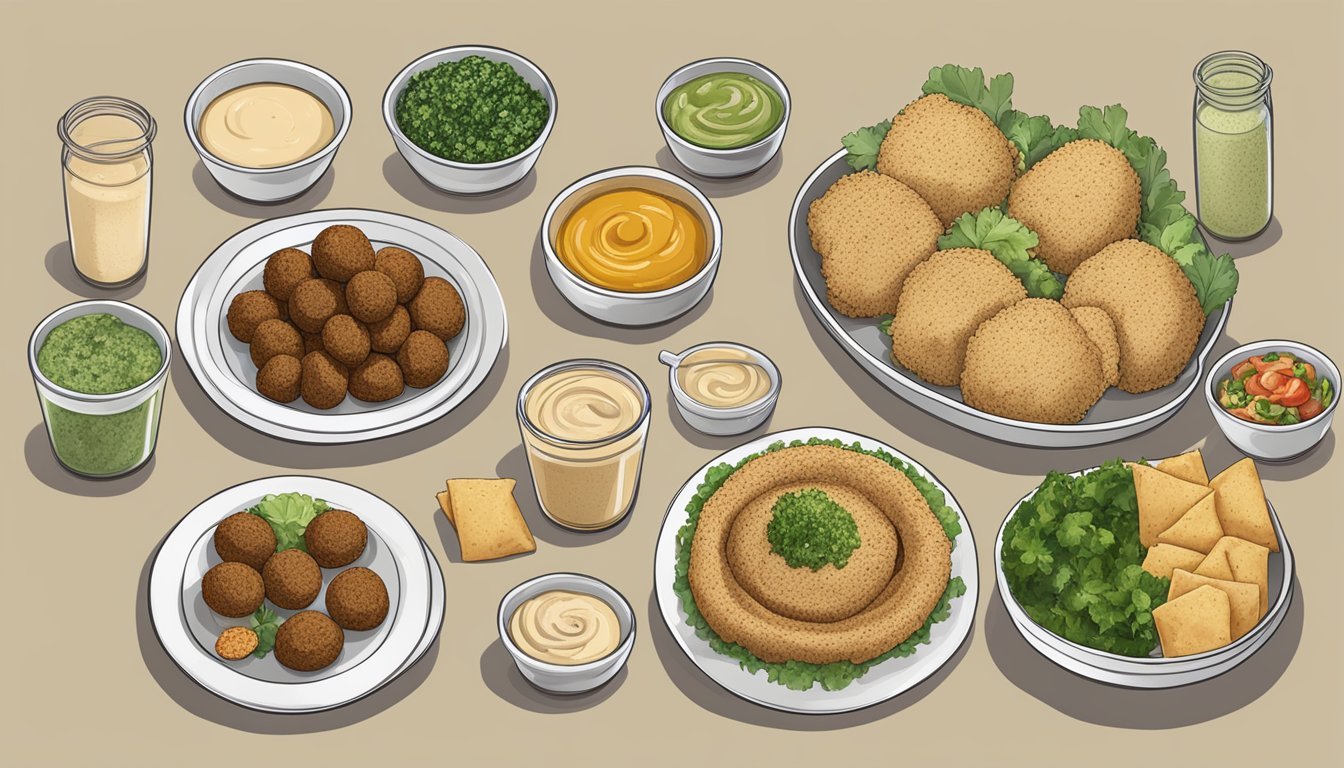Boxed Falafel Mix Hacks
Elevate Your Quick Meals with These Tips
Boxed falafel mix offers a convenient starting point for creating delicious falafel at home, without the need for extensive preparation or specialized ingredients. These pre-made mixes typically contain ground chickpeas, herbs, and spices, requiring only the addition of water and a brief resting period before cooking. However, even with the simplification that a boxed mix provides, there are clever hacks one can employ to elevate the humble falafel to a dish with a homemade feel and tailored flavors.
For those looking to enhance their falafel, it's useful to consider the texture and seasoning that can be introduced beyond the instructions on the box. Adding fresh ingredients like minced parsley, cilantro, or grated garlic can infuse the falafel with bright, aromatic notes. Incorporating additional spices such as cumin, coriander, or even a touch of curry powder can deepen the flavor profile, ensuring that each bite is packed with taste. By understanding the foundational elements of traditional falafel, cooks can adeptly modify the boxed mix to suit their personal preferences or to mimic the flavors found at their favorite falafel stand.
Cooking methods also play a critical role in achieving the perfect falafel. Traditionally deep-fried, falafel can also be baked or air-fried for a healthier alternative without sacrificing the coveted crispy exterior. Each technique has its nuances with different temperature and time requirements, suggesting that a bit of experimentation could lead to the discovery of the perfect method for one's particular kitchen setup and health considerations. The adaptability of the boxed falafel mix to various cooking methods showcases its versatility, making it an ideal option for quick weeknight dinners or for entertaining guests with dietary restrictions.
Selecting Your Boxed Falafel Mix
When selecting a boxed falafel mix, consumers should pay close attention to the ingredients and nutrition labels to ensure the product meets their dietary preferences and health considerations.
Evaluating Ingredients for Quality
The quality of a falafel mix is largely determined by its ingredients. A high-quality mix typically lists chickpeas or fava beans as the first ingredient, ensuring authenticity and flavor. Other components may include spices like cumin and coriander, as well as preservative-free add-ins like garlic and onion powder for enhanced taste. It's crucial to look for mixes without unnecessary fillers or artificial additives.
Desirable Ingredients Ingredients to Avoid Chickpeas/Fava Beans Artificial Flavors Spices (Cumin, Coriander) Preservatives Garlic Powder Unnecessary Fillers Onion Powder Artificial Additives
Understanding Nutrition Labels
The nutrition label on a falafel mix provides valuable information regarding its healthfulness. Consumers should examine the label for fiber and protein content, as these are indicators of a nutritious choice. A good mix should be rich in protein, contributing to satiety and muscle maintenance. Fiber content is key for digestive health.
Consumers are advised to check the calories per serving to manage energy intake. Additionally, sodium levels are an important consideration, especially for those monitoring their salt consumption. One should look for lower sodium options to help maintain a balanced diet.
Nutrient Recommended Range Protein High Fiber High Calories Moderate Sodium Low to Moderate
By focusing on these details, buyers can choose a falafel mix that is not only tasty but also aligns with their health objectives.
Preparation Techniques
The success of boxed falafel mix hinges on mastering the preparation steps, from hydration to cooking. These tips will ensure a flavorful and desired texture in the final product.
Mixing and Hydration Tips
For a cohesive mixture, proper hydration is key. Mix the specified amount of water—usually 3/4 cup to 1 cup of dry mix. Let the mix stand covered for 30-60 minutes to allow the flavors to meld and the mixture to thicken. Ingredients like fresh herbs or minced garlic can be blended in to elevate the falafel's taste profile.
Forming Perfect Patties and Balls
Uniform falafel patties or balls are crucial for even cooking. A small ice cream scoop or a 1/4 cup measure can help achieve consistent sizing. Once scooped, they should be shaped by hand or with the help of parchment paper to prevent sticking, with a gentle compactness to maintain shape during cooking.
Baking vs. Frying Methods
Both baking and frying affect the falafel's texture. For those seeking a healthier option, baking at 375 degrees Fahrenheit can yield a drier but still flavorful result. To achieve the traditional crispy exterior, frying in an inch of oil heated to 350-375 degrees Fahrenheit works best, turning the falafel carefully to brown all sides evenly. Whether baking or frying, it's important not to overcrowd the cooking space to allow for even heat distribution.
Flavor Enhancements
Boxed falafel mixes can be greatly improved with the introduction of fresh ingredients and a careful selection of spices and herbs. These enhancements not only add depth to the flavor but also bring a homemade touch to an otherwise standard mix.
Incorporating Fresh Ingredients
Introducing fresh ingredients into a boxed falafel mix can significantly elevate the final product. The addition of fresh garlic, rather than powdered, can add a more robust aroma and a zesty kick. Squeezing in some fresh lemon juice provides a burst of citrus that brightens the overall taste. For a verdant, herbaceous quality, finely chopped fresh parsley or fresh cilantro can be mixed into the batter. These ingredients together create a fresher, more flavorful falafel.
Garlic: Add 1-2 minced cloves to the mix for heightened flavor.
Lemon Juice: Incorporate 1 tablespoon for a subtle tang.
Fresh Parsley/Cilantro: Mix in 1/4 cup chopped herbs for a fresh taste.
Customizing with Spices and Herbs
The careful choice of additional spices and herbs can transform a bland boxed mix into a falafel bursting with the complexity of flavors. Cumin is a staple spice in falafel and adding a bit more can intensify the earthy warmth. Freshly ground black pepper and a pinch of cayenne or chili pepper flakes can introduce a spicy undertone. Each herb and spice plays a role in creating a balanced and aromatic experience.
Cumin: Stir in 1 teaspoon for traditional warmth.
Black Pepper: Add 1/2 teaspoon, freshly ground preferred, for a sharper edge.
Cayenne/Chili Pepper Flakes: Sprinkle in 1/4 teaspoon for a hint of heat.
Alternative Cooking Methods
Boxed falafel mix provides a convenient and tasty base for creating falafel, but one can move beyond traditional deep-frying to explore healthier and equally delicious cooking methods. This section introduces two popular approaches for preparing falafel using boxed mix: air frying and skillet cooking.
Air Fryer Adaptation
An air fryer offers a way to achieve the crispy texture of fried falafel without the need for excessive oil. To adapt boxed falafel mix for air frying, users should preheat their air fryer to 400 degrees F. After preparing the mix as instructive, they can shape it into balls or patties, lightly coat with cooking spray, and arrange in the air fryer basket, ensuring to space them evenly for optimal airflow.
Cooking time: Depending on the air fryer model, cook falafel for about 14-15 minutes, until they are golden brown and crisp.
Remember to flip the falafel halfway through cooking, which helps to brown all sides evenly.
Skillet Cooking
For those who prefer skillet cooking, the process is straightforward. After mixing the falafel mix according to package instructions, it should be formed into balls or patties. One then heats a small amount of oil in a skillet over medium heat until it sizzles upon contact with a droplet of water.
Carefully place the falafel in the oil and fry until each side is deeply golden and crispy, typically for about 3-5 minutes per side.
Using a spatula, flip the falafel carefully to prevent breakage and ensure even cooking.
Both methods offer a delicious alternative to deep frying, maintaining taste while providing a less oily finish.
Serving Suggestions
When it comes to elevating a boxed falafel mix with versatile serving suggestions, one should consider both accompanying dishes and falafel as a standalone protein source. The aim is to create a well-rounded and satisfying meal or appetizer that is both flavorsome and nutritionally balanced.
Companion Dishes
A quintessential companion to falafel is pita bread. The warm, fluffy bread offers a perfect pocket or wrap to cradle the falafel, alongside crisp lettuce and slices of red onion. Enhancing the dish with tahini sauce or hummus adds a rich, creamy element that complements the hearty texture of the falafel balls. Alternatively, a drizzle of tzatziki sauce introduces a refreshing contrast with its cucumber and yogurt base.
For a lighter option, one might pair falafel with a salad consisting of tomatoes, cucumbers, and lettuce, dressed in a simple vinaigrette. The freshness of the vegetables balances the spice-infused falafel, creating a meal that is both nutritious and fulfilling.
Pita Pairing
Pita bread (warm)
Lettuce (crisp)
Red onion (sliced)
Hummus or Tahini sauce
Tzatziki sauce (optional)
Salad Pairing
Lettuce, tomatoes, cucumbers (fresh)
Vinaigrette dressing
Falafel as a Main Protein Source
When falafel is featured as the central protein in a meal, it can be served in various inventive ways. Boldly seasoned and packed with plant-based protein, falafel is fitting for those seeking a meat alternative that doesn't sacrifice flavor or substance. It can play a starring role atop a bountiful salad or as a filling entrée next to roasted vegetables and grains.
As an appetizer, falafel balls can be served on a platter with tzatziki, tahini sauce, and hummus for dipping. This not only showcases the falafel's versatility but also caters to a variety of taste preferences.
Entrée
Salad (generous and well-dressed)
Roasted vegetables
Grains (quinoa, rice, or bulgur)
Appetizer Platter
Falafel balls
Tzatziki sauce
Tahini sauce
Hummus
Health Considerations
When incorporating boxed falafel mix into a diet, it's crucial to consider allergens and caloric content to ensure the food aligns with one's health goals and dietary restrictions.
Understanding Allergens
Boxed falafel mixes may contain allergens such as wheat (gluten), sesame, or soy. Those following a gluten-free diet should verify if the mix is labeled as such, as falafel traditionally includes chickpeas and herbs that are inherently gluten-free. For individuals with sesame allergies, care should be taken, as this ingredient is commonly found in tahini, a popular falafel condiment.
Calorie and Macro Management
A single serving of falafel typically contains around 190 to 300 calories, with macros consisting of complex carbohydrates, protein, and dietary fiber. Since falafel is vegan, it provides plant-based protein, making it suitable for those on a vegan diet. For those monitoring caloric intake or seeking lower fat options, consider baking or air frying instead of deep-frying.
Preparation Method Calories Fat (g) Protein (g) Fiber (g) Air Fryer ~191 4 Varies Varies Baked Varies Low Varies Varies Deep Fried High High Varies Varies
Adjustments in the preparation of falafel, such as using an air fryer or oven, can *reduce fat content significantly while still yielding a crispy texture.
Preserving Leftovers
Proper storage techniques are essential to extend the shelf life of leftover falafel, maintaining its freshness and flavor. Whether storing in the fridge or freezer, understanding the correct methods can ensure that falafel remains delicious for later consumption.
Refrigerator Storage Tips
To keep leftover falafel fresh in the refrigerator, they should be stored in an airtight container. This method helps to prevent them from absorbing moisture and odors from other foods.
Airtight Container: Use shallow, sealed containers to minimize air exposure.
Temperature: Ensure your fridge is at or below 40°F (4°C) to prevent bacterial growth.
One can expect the falafel to stay fresh for up to three to five days when refrigerated properly.
Freezing and Reheating
For longer preservation, freezing falafel is a reliable option. When freezing, place the falafel on a baking sheet, not touching, and freeze until solid. Then, transfer the frozen falafel to an airtight bag or container, labeling it with the current date.
Freezing Steps:
Place on baking sheet and freeze individually.
Transfer to airtight container or freezer bag.
Label with date of freezing.
To reheat, one doesn't need to thaw the falafel; they can be warmed directly in an oven or air fryer.
Reheating from Frozen:
Oven: Preheat to 375°F and reheat for 10-15 minutes, or until heated through.
Air Fryer: Preheat to 350°F (approximately 180°C) and reheat for about 5-10 minutes.
By following these storage tips, one can enjoy their falafel at a later date without compromising on the quality or taste.
DIY Mix Customization
Customizing a boxed falafel mix not only adds a personal touch but can also enhance flavor and texture. These hacks can transform an ordinary mix into a gourmet experience with just a few additions and tweaks.
Creating Your Own Blend
Individuals seeking a bespoke flavor for their falafel can start by enhancing the dry mix. One can incorporate a variety of ground spices such as cumin, coriander, paprika, turmeric, and chili powder to introduce depth and warmth. Adding dried herbs like mint or parsley, or fresh herbs finely chopped ensures a fresh, aromatic lift. For those who prefer a lighter taste, a dash of lemon juice can brighten the flavors.
When considering the binding and leavening agent, baking powder can be added. A pinch of this ensures that the falafel remains light and fluffy when cooked. Here's an example blend:
2 tsp ground cumin
1 tsp ground coriander
1 tsp smoked paprika
1/2 tsp turmeric
1/4 tsp chili powder
1 tbsp dried parsley or a small handful of fresh parsley, finely chopped
1/4 tsp baking powder
Juice of half a lemon
Using Presoaked Chickpeas
For those attempting a more traditional approach to falafel, using presoaked chickpeas is the way to go. They should opt for dried chickpeas soaked overnight rather than canned chickpeas, as the latter can be too soft and may affect the texture negatively. After soaking, one should blend the chickpeas until they are finely ground but not pureed. This creates the ideal consistency for authentic falafel, providing the texture that is both crunchy on the outside and tender inside.
Whether it's adding a handful of fresh herbs like parsley or cilantro, or using presoaked chickpeas, personalizing a falafel mix can add a delightful twist to this classic Middle Eastern dish.
Gourmet Garnishes and Toppings
Elevating a simple falafel mix can be effortlessly achieved with the right gourmet garnishes and toppings. One can transform a basic meal into a Mediterranean feast by exploring traditional pairings and crafting homemade creamy sauces (What wine goes well with creamy sauces?).
Explore Mediterranean Pairings
The heart of Mediterranean flavor lies in its fresh and vibrant pairings. To begin, tahini sauce serves as a smooth, nutty condiment that perfectly complements the crispy texture of falafel. It can be easily enhanced with a squeeze of lemon juice and a hint of garlic for zesty undertones. For a refreshing touch, one might add a cucumber and tomato salad or freshly chopped parsley. These garnishes not only add a burst of color but also incorporate a balance of flavors that are quintessential to the region.
Suggested Toppings:
Tahini Sauce: Combine tahini paste, lemon juice, minced garlic, and water to reach desired consistency.
Parsley: Chop fresh parsley for a bright, herby garnish.
Pickled Vegetables: (What wine goes well with pickled vegetables?) Include for a tangy crunch.
Crafting Creamy Sauces
Crafting creamy sauces at home allows for a personalized touch to each falafel dish. Hummus, with its creamy texture and savory taste, serves as both a spread and a dip, offering a protein-packed complement. On the other hand, tzatziki sauce, with its yogurt base, dill, cucumber, and garlic, offers a cool and tangy contrast to the warm spices of falafel. These sauces should be smooth and hearty, acting as the perfect glue to hold together all the elements in a falafel wrap or sandwich.
Sauce Recipes:
Hummus: Blend chickpeas, olive oil, tahini, lemon juice, and garlic until smooth.
Tzatziki Sauce: Combine Greek yogurt, grated cucumber, minced garlic, olive oil, and dill.
Troubleshooting Common Issues
Proper preparation of boxed falafel mix can steer one clear of common pitfalls when cooking falafel. Mainly, cooks face issues with disintegration during cooking and not achieving a crunchy texture.
Avoiding Disintegration During Cooking
Falafel disintegration is often a result of oil temperature inconsistencies. One should ensure the oil is heated properly, typically to 356°F (180°C), before adding the falafel. An ideal way to test if the oil is ready is to use a thermometer or drop a tiny piece of the mix into the oil; it should bubble and float without breaking apart.
Key Steps:
Preheat oil to a steady 356°F (180°C).
Test oil readiness with a falafel mix piece.
Additionally, falafels made from a smoother mix tend to hold together better during frying. Allowing the falafel mixture to stand for at least 30-60 minutes after mixing with water will also help the ingredients bind properly to avoid disintegration.
Achieving the Desired Crunchiness
The crunchy outer layer, with a soft interior, is a hallmark of a well-made falafel. For a boxed mix, achieving this texture starts from the water-to-mix ratio and ends with the cooking method. A common mistake is making the mixture too wet, which results in a soft and sometimes soggy falafel. Follow the box’s water-to-mix ratio closely, and if necessary, adjust slightly to form a mixture that’s not overly sticky or too dry.
Bread Crumb Coating:
For extra crunch, roll the shaped falafel in a thin layer of dry falafel mix before frying.
If using an oven to cook falafel, a preheated 375 degrees environment is necessary to get a crunchy exterior. Ensure the falafel balls are placed on a lightly greased baking tray to prevent sticking and allow even cooking.
By following these guidelines, cooks can ensure their falafels are robust and ready for a delightful crunch.
Consumer Resources
In this section, consumers will find curated information on where to source high-quality boxed falafel mix and accompanying ingredients.
Recommended Brands and Products
Trader Joe's Falafel Mix: Known for providing a variety of Mediterranean food options, Trader Joe's offers a falafel mix that is both vegan and gluten-free. Consumers appreciate the simplicity of the preparation steps, despite the required wait time of 30-60 minutes before cooking.
Brands to Consider:
Trader Joe's: Vegan, gluten-free, and well-reviewed for taste.
McDaniel Short-Cuts: Offers a recipe that can be baked in an oven, providing a healthier alternative to frying.
It is recommended to check for product reviews and ingredient labels when selecting a falafel mix to ensure it meets dietary preferences and flavor expectations.
Where to Buy Ingredients
Consumers often find that the freshest vegetables and meats to pair with falafel mix can be sourced from local farmers' markets or specialty Mediterranean grocery stores.
Vegetables: Fresh vegetables such as parsley, tomatoes, lettuce, and cucumbers complement falafel well and can be found at local produce markets.
Meat: For consumers preferring meat alongside their falafel, a sauté of chicken or beef from a reputable butcher can enhance the meal.
Buying ingredients from dedicated food markets may not only support local businesses but also ensures high-quality, flavorful additions to the meal.
Where to Purchase:
Ingredient Category Suggested Retailers Boxed Falafel Mix Trader Joe's, Health Food Stores, Online Fresh Vegetables Farmers' Markets, Organic Food Stores Meat Butcher Shops, Grocery Store Meat Section
Innovative Serving Ideas
Exploring the versatility of boxed falafel mix can transform it into innovative dishes beyond its traditional use. These serving ideas encompass both classic snack preparations and inventive inclusions as part of any meal.
Falafel Beyond the Traditional
Lettuce Wraps: A lighter alternative to pitas, crisp lettuce leaves can be used as a wrap for falafel balls. They can prep the wraps in under 5 minutes, adding a fresh crunch that complements the spiced flavors of the falafel.
Salad Topper: They can crumble cooked falafel over salads to create a hearty, protein-rich topping. Serving it as a side dish is quick; they can complete it in under 10 minutes, elevating a simple green salad to a more satisfying meal.
Snack Preparations
Falafel Sliders: For a snack-sized appetizer, they can place mini falafel patties into small buns. Adding a dab of tzatziki or tahini sauce ensures a flavorful bite that guests can enjoy.
Pita Chips and Falafel Dip: They can repurpose the falafel mix into a savory dip. By blending the mix with less water, individuals can create a thicker consistency perfect for scooping with pita chips. This quick and easy preparation is ideal for snacking or as an appetizer for any occasion.
Expert Tips and Tricks
Maximizing the potential of boxed falafel mix not only saves time but also can yield results that rival authentic recipes. Below are chef-endorsed strategies and time-efficient practices to elevate this convenient food product.
Chefs’ Secrets for Perfect Falafel
Texture and Flavor: For the ideal texture, chefs recommend hydrating the dry mix with water—typically 3/4 cup of water to 1 cup of dry mix. After blending and letting it sit for 30 to 60 minutes, adding fresh ingredients like parsley, lemon juice, and garlic enhances the flavor profile considerably. Pulse the mixture until just combined, careful not to over-process as maintaining some texture is crucial for the best falafel.
Shaping and Cooking: To achieve uniformity in size and ensure even cooking, one can use an ice cream scoop or a 1/4 cup measuring spoon to portion the mix. Fry or bake as detailed in the recipe card included with the mix. For frying, use at least an inch of oil, and for baking, preheat the oven to 375°F (190°C).
Time-Saving Preparation Hacks
Air Fryer Method: An air fryer offers an easy recipe alternative that is healthier and quicker than traditional methods. For air-fried falafel, set the air fryer to 380°F (193°C) and cook for 15-18 minutes. The result is a golden brown falafel that's crisp on the outside.
Pre-mix Seasoning Enhancements: To save on prep time, one can mix seasonings directly into the boxed mix before hydration. Add a personal twist with spices such as ground coriander, cumin, mint, or even a pinch of curry powder. Review the mix's flavor profile and adjust the seasoning to personal taste.
By adhering to these strategies, cooks can transform a simple boxed mix into a falafel experience that resonates with authentic quality while being extraordinarily simple to prepare. Opt for these expert tips to elevate the humble boxed mix to heights that surprise and satisfy.
Conclusion
Boxed falafel mixes provide a convenient starting point for creating delicious falafel. With a few creative hacks, one can improve both flavor and texture, bringing them closer to homemade quality.
Flavor Enhancement: To elevate flavor, consider adding fresh herbs like parsley or coriander. Spices such as cumin or coriander can also add depth. Incorporating finely chopped onions or garlic introduces a piquant freshness that pre-packaged mixes often lack.
Texture Tuning: For the desired texture, adjusting the liquid content before shaping is crucial. The mix should be moist enough to hold together but not so wet that it becomes gummy. Letting the mixture rest allows the ingredients to hydrate properly, yielding a better texture.
Size Consistency: Falafel balls or patties should be uniform in size to ensure even cooking. Using a small scoop or measuring cup can help achieve this consistency, and result in a more professional presentation.
Healthier Alternatives: One can also bake falafel instead of frying to reduce oil content. To maintain a crispy exterior, preheating the baking sheet and a light brush of oil on the falafel can mimic the crunchiness of frying.
In summary, with these hacks, one can transform boxed falafel mix into a gourmet experience that rivals homemade versions. Not only does this enhance the dining experience, it also offers a healthier, more customizable option suitable for a variety of dietary preferences while ensuring the ease of a ready-made mix is not lost.













